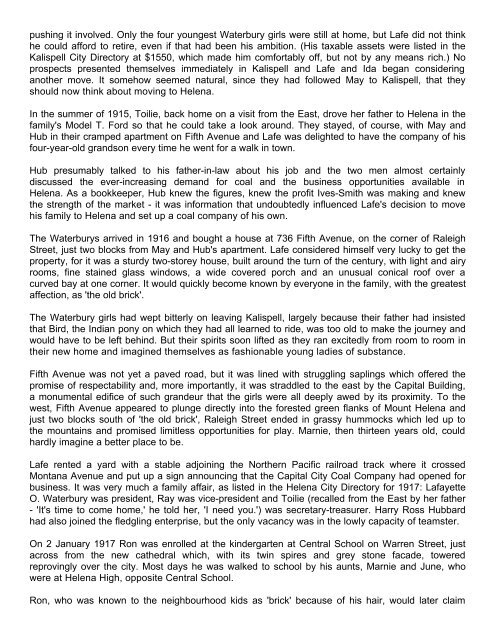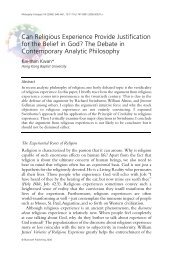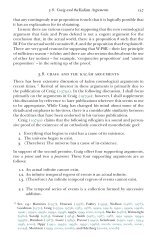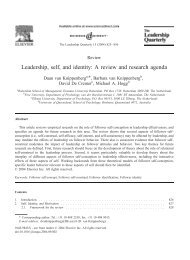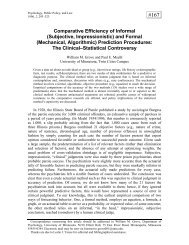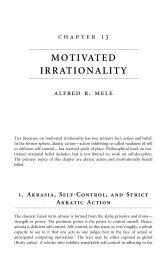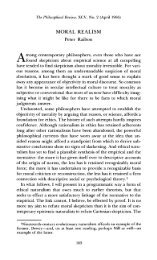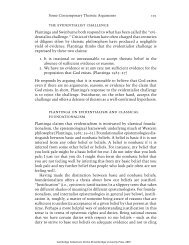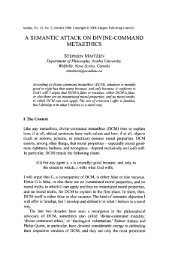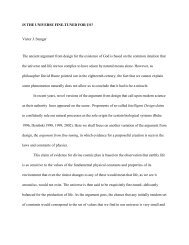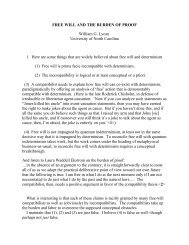- Page 2 and 3: INDEX Foreword by Chris Owen Author
- Page 4 and 5: Foreword By Chris Owen Truth, ficti
- Page 6 and 7: Introduction For more than forty ye
- Page 8 and 9: By then Hubbard was nearly seventy
- Page 10 and 11: Chapter 1 A Dubious Prodigy Accordi
- Page 12 and 13: heavy with child; a daughter, Ledor
- Page 14 and 15: and play his fiddle, which had a ne
- Page 16 and 17: The hospital in Tilden, Nebraska, w
- Page 18 and 19: Little Ron in a sailor hat. One day
- Page 22 and 23: war notwithstanding. He had been se
- Page 24 and 25: complained to the Navy Department,
- Page 26 and 27: 1. Oregon Journal, 22 Apr 1943 2. M
- Page 28 and 29: Chapter 2 Whither did he Wander? Fu
- Page 30 and 31: about how anyone with red hair was
- Page 32 and 33: Ron's first impression of Guam, wit
- Page 34 and 35: [He had, in fact, been thirteen. Bu
- Page 36 and 37: teacher and put his butt into a was
- Page 38 and 39: The Travels of Ron 2 - Asian Odysse
- Page 40 and 41: gentle coaching of his mother. In O
- Page 42 and 43: long expected will donation.' On pa
- Page 44 and 45: The Hubbards returned to the United
- Page 46 and 47: Hubbard learned to fly a glider whi
- Page 48 and 49: A few years later Ron would provide
- Page 50 and 51: sixteen ports on the islands of Mar
- Page 52 and 53: Among the scientific accomplishment
- Page 54 and 55: 11. The Hatchet, 24 May 1932 12. Le
- Page 56 and 57: Although she was nearly four years
- Page 58 and 59: 'And here's my plea. Isn't there so
- Page 60 and 61: it be a Congressional hearing or ju
- Page 62 and 63: Interspersed between these gripping
- Page 64 and 65: Although the house had three rooms
- Page 66 and 67: . . . Polly could hardly believe he
- Page 68 and 69: 6. Certified airman's file 7. Adven
- Page 70 and 71:
always accompanied by a flood of ne
- Page 72 and 73:
existence of the book, with the exc
- Page 74 and 75:
Westerns, but only about three or f
- Page 76 and 77:
the Explorers Club on the basis of
- Page 78 and 79:
sister, according to Ron, was a mem
- Page 80 and 81:
was angry that Marnie should involv
- Page 82 and 83:
When he was not working, Ron spent
- Page 84 and 85:
6. L. Ron Hubbard, Mission Into Tim
- Page 86 and 87:
ecruiting, all of which were 'going
- Page 88 and 89:
Censor in Washington recommended th
- Page 90 and 91:
without dark glasses. Moulton, unde
- Page 92 and 93:
were men of experience, displayed a
- Page 94 and 95:
Fletcher added that there was a 'kn
- Page 96 and 97:
the war in the Pacific was of bitte
- Page 98 and 99:
Monterey, California, for further t
- Page 100 and 101:
Chapter 7 Black Magic and Betty 'Hu
- Page 102 and 103:
times through a sacred fire, but th
- Page 104 and 105:
eautiful, the most gorgeous, intell
- Page 106 and 107:
a table lamp in the corner of his b
- Page 108 and 109:
Come unto me, to me! Sing the raptu
- Page 110 and 111:
the partnership could purchase its
- Page 112 and 113:
friend to provide independent corro
- Page 114 and 115:
Chapter 8 The Mystery of the Missin
- Page 116 and 117:
to put together an imaginative and
- Page 118 and 119:
'He opened his eyes and found a nur
- Page 120 and 121:
Forrest Ackerman, who had noticeabl
- Page 122 and 123:
a minute. It just poured out - I ha
- Page 124 and 125:
added that he was also working on a
- Page 126 and 127:
Chapter 9 The Strange Début of Dia
- Page 128 and 129:
Winter still felt the subject was w
- Page 130 and 131:
time permits a true evaluation of t
- Page 132 and 133:
ank and perfect function. Every hum
- Page 134 and 135:
claimed were the most common cause
- Page 136 and 137:
off the hook all day. Everyone want
- Page 138 and 139:
Republic weighed in by describing t
- Page 140 and 141:
Chapter 10 Commies, Kidnaps and Cha
- Page 142 and 143:
As people began getting up and walk
- Page 144 and 145:
things they were doing in China and
- Page 146 and 147:
LA Foundation. 'I think Sara must h
- Page 148 and 149:
or Hoax?' The text left the reader
- Page 150 and 151:
Avenue, he told Barbara about an oc
- Page 152 and 153:
last agreed on a temporary truce. H
- Page 154 and 155:
They were unlikely fellow traveller
- Page 156 and 157:
All the salacious details were incl
- Page 158 and 159:
Chapter 11 Bankrolling and Bankrupt
- Page 160 and 161:
a letter, dated 2 May, that she had
- Page 162 and 163:
concur and Hubbard's letter was tuc
- Page 164 and 165:
on to the New York Times's bestsell
- Page 166 and 167:
Understandably, the VA saw no cause
- Page 168 and 169:
His relief was premature. Early in
- Page 170 and 171:
Chapter 12 Phoenix Rising 'Many awa
- Page 172 and 173:
Even judged by the standards of his
- Page 174 and 175:
The portly Nibs (second from right)
- Page 176 and 177:
She was disappointed to register no
- Page 178 and 179:
In February 1953, Hubbard decided i
- Page 180 and 181:
On 15 August he wrote again, pleadi
- Page 182 and 183:
door. Ron went and talked to a guy
- Page 184 and 185:
Chapter 13 Apostle of the Main Chan
- Page 186 and 187:
individuals and organizations aroun
- Page 188 and 189:
Hubbard with his friend Ray Kemp on
- Page 190 and 191:
nuclear weapons by 'as-ising' the a
- Page 192 and 193:
operate as a religion in Washington
- Page 194 and 195:
Hubbard as genial family man. From
- Page 196 and 197:
Chapter 14 Lord of the Manor 'My ow
- Page 198 and 199:
evealed, gardener to gardener, his
- Page 200 and 201:
financial affairs in the most optim
- Page 202 and 203:
family dining-room, which included
- Page 204 and 205:
Hubbard's blossoming omnipotence wa
- Page 206 and 207:
and also solved his perspiration pr
- Page 208 and 209:
Chapter 15 Visits to Heaven 'Well,
- Page 210 and 211:
pocket. He is there to trick you in
- Page 212 and 213:
practice a serious threat to the co
- Page 214 and 215:
lackhearted politicians, no matter
- Page 216 and 217:
Nothing of this was revealed to the
- Page 218 and 219:
insisted they should remain unfurle
- Page 220 and 221:
Well, I have been to Heaven. HUBBAR
- Page 222 and 223:
laid out like Bush Gardens in Pasad
- Page 224 and 225:
much harder on the pc even though i
- Page 226 and 227:
ATTACKS ON SCIENTOLOGY (from the Fo
- Page 228 and 229:
Society is pretty crazy. It's a raw
- Page 230 and 231:
(3) Stress sex and blood in psychia
- Page 232 and 233:
Hubbard had no more intention of co
- Page 234 and 235:
Virginia Downsborough did not obser
- Page 236 and 237:
Hubbard would show up every couple
- Page 238 and 239:
ed-faced man boomed, 'Mr Hubbard is
- Page 240 and 241:
'I arrived back on board at about f
- Page 242 and 243:
hundred-mile voyage completed witho
- Page 244 and 245:
Chapter 17 In Search of Past Lives
- Page 246 and 247:
not, what mattered was being able t
- Page 248 and 249:
island of Corsica. Hubbard had show
- Page 250 and 251:
urging Hana Eltringham to somehow g
- Page 252 and 253:
After the television interview, Hub
- Page 254 and 255:
Two members of the Sea Org hoist an
- Page 256 and 257:
signed a receipt for the letter and
- Page 258 and 259:
the island's notorious Lotharios. H
- Page 260 and 261:
Opposite the desks is the impressiv
- Page 262 and 263:
(6) When the owners first requested
- Page 264 and 265:
Chapter 18 Messengers of God 'It is
- Page 266 and 267:
Despite the continuing restrictions
- Page 268 and 269:
Two days later, Doreen received a n
- Page 270 and 271:
them ran to tell the Commodore what
- Page 272 and 273:
all with copies to President Nixon,
- Page 274 and 275:
French and Arabic, the arrival of '
- Page 276 and 277:
6. Affidavit of Gerald Armstrong, 1
- Page 278 and 279:
The three of them checked in using
- Page 280 and 281:
Most official photographs of Hubbar
- Page 282 and 283:
agreed to be examined by a local do
- Page 284 and 285:
While Hubbard had been suffering so
- Page 286 and 287:
Ken Urquhart, who probably knew mor
- Page 288 and 289:
get the ship next time she arrived
- Page 290 and 291:
marks and Swiss francs in high-deno
- Page 292 and 293:
months later. The Apollo had not be
- Page 294 and 295:
ound the block and then come in the
- Page 296 and 297:
agents into the US Attorney's offic
- Page 298 and 299:
smoking cigarettes like mad and eve
- Page 300 and 301:
two U-Haul trailers parked outside.
- Page 302 and 303:
Angeles airport, said he was leavin
- Page 304 and 305:
Chapter 21 Making Movies 'The crime
- Page 306 and 307:
which he believed would rid the wor
- Page 308 and 309:
Behind the security screen, the Com
- Page 310 and 311:
yelling all the time. People were r
- Page 312 and 313:
Everyone would work in a frenzied s
- Page 314 and 315:
painting. Its main street signs ref
- Page 316 and 317:
strange and secretive world of the
- Page 318 and 319:
Broeker also directed, apparently a
- Page 320 and 321:
least two or three copies each. Bat
- Page 322 and 323:
Mr Justice Latey had been hearing a
- Page 324 and 325:
The incident did not bother Whaley
- Page 326 and 327:
About the Author Russell Miller was
- Page 328 and 329:
1978, What Is Scientology? (Church
- Page 330 and 331:
Chapter 15 Original paragraph from
- Page 332 and 333:
Suppressive Persons How the Church
- Page 334 and 335:
The Bare-Faced Messiah Interviews L
- Page 336 and 337:
much account. He had a little studi
- Page 338 and 339:
Polly was from Maryland, I don't re
- Page 340 and 341:
He never talked about the workings
- Page 342 and 343:
went through them one by one. Final
- Page 344 and 345:
The Bare-Faced Messiah Interviews I
- Page 346 and 347:
and papers were speculating whether
- Page 348 and 349:
One night, in the midst of our affa
- Page 350 and 351:
In Oakland, after the lecture, a ve
- Page 352 and 353:
He said Sara had hypnotised him in
- Page 354 and 355:
The Bare-Faced Messiah Interviews I
- Page 356 and 357:
Beverly Hills of Havana. We moved i
- Page 358 and 359:
control. He took the child from the
- Page 360 and 361:
you want to go there?" The justific
- Page 362 and 363:
First I took up a cup of hot chocol
- Page 364 and 365:
There were so many policies you cou
- Page 366 and 367:
Saint Hill but he contained it; on
- Page 368 and 369:
work and I knew reports could bothe
- Page 370 and 371:
The Bare-Faced Messiah Interviews I
- Page 372 and 373:
messengers and me sitting on the fl
- Page 374 and 375:
was to get up, handle comm[unicatio
- Page 376 and 377:
We came out to LA to an overland ve
- Page 378 and 379:
use new money with the first and la
- Page 380 and 381:
would walk with him and a couple we
- Page 382 and 383:
Interview - 28 August 1986 My first
- Page 384 and 385:
He did do a lot of research and had
- Page 386 and 387:
After he recovered and got up, he n
- Page 388 and 389:
care if it was true or not. I wasn'
- Page 390 and 391:
idea (this was while we were at Hem
- Page 392 and 393:
The Bare-Faced Messiah Interviews I
- Page 394:
For so many people the desire was t


